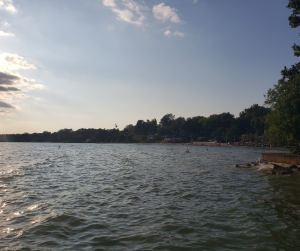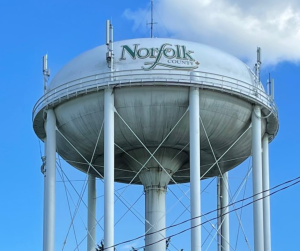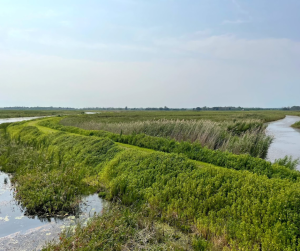Source Water Protection
Protection Policy
In May 2000, heavy rain washed E. coli bacteria into a well providing water to the town of Walkerton. A series of human and mechanical failures allowed the bacteria to enter the municipal water supply. Seven people died, and more than 2,300 were ill.
As a result, the Ontario government set up the Walkerton Inquiry under Justice Dennis O’Connor. He issued a two-volume report with 121 recommendations to prevent a similar event from happening again. The Clean Water Act implements some of these recommendations by employing a multi-barrier approach to ensure the safety of drinking water across all municipalities, from source to tap.
The first step in the multi-barrier approach is protecting the surface water and groundwater that supplies Norfolk County’s five water treatment systems. This is called Source Protection and involves conducting a risk assessment and controlling these threats to our drinking water systems.
Click on any of the following questions to read more about each topic.
What is the Clean Water Act and how does it fit into source protection?Protecting water at the source is the first step to a multi-barrier approach and an important part of ensuring the health of people, ecosystems and economies. Provincial laws such as the Safe Drinking Water Act and the Ontario Water Resources Act are in place to regulate other key elements of the multi-barrier approach including effective water treatment, adequate testing, rigorous monitoring, operator training, permits to take water and to regulate industrial pollution.
Each surface water intake has an Intake Protection Zone (IPZ) that prohibits activities that could contaminate the drinking water source. Similarly, each wellhead has a Well Head Protection Area (WHPA) that ensures the groundwater surrounding each well remains contaminant-free.
Norfolk County’s policy mapper shows all areas affected by source water protection policies.
Similarly, an Intake Protection Zone (IPZ) is the area around an intake pipe in a lake or river that draws in the surface water where certain activities can negatively impact the drinking water supply.
Norfolk County is one of many stakeholders that sit on the Lake Erie Source Protection Committee, which is responsible for identifying and managing current and future threats to drinking water in the region. The committee has developed an official plan through science-based assessments and public consultations to reduce, eliminate, or manage the identified risks. Municipalities like Norfolk County, source protection authorities, local health boards, the province and others are required to implement the policies outlined in the plan and report on their progress.
You can see Long Point Region’s Plan here and Grand River’s plan here.
The committees publicly consult regarding important decisions. Notices will be posted on Norfolk County’s website when public consultation is taking place.
Treating drinking water is very costly, and some hazardous chemicals are extremely difficult to remove using conventional drinking water treatment systems. Therefore, the best way to ensure high-quality drinking water is to keep source water clean and free of these difficult-to-remove contaminants.
The source protection plan identifies two types of areas where the plan applies:
- Wellhead Protection Areas (WHPA) around municipal drinking water wells.
- Intake Protection Zones (IPZ) around river and lake intakes
- Natural and chemical contaminants
- Irresponsible land use activities which contaminate our water or take too much out
- Urban development can make it difficult for water to filter into the ground in order to replenish groundwater sources. When this happens, water just flows across the surface of the land rather than percolating down to recharge groundwater sources
- Air pollution from vehicles, coal plants, industries and other sources that fall directly on surface waters or enter water sources through surface runoff
As a result of climate change, there is also concern that the warming of the Earth’s atmosphere will reduce the amount of water available in lakes, rivers and streams due to reduced precipitation and increased evaporation.
The following activities have been prescribed as threats by the Ministry of Environment and Climate Change (MOECC), when occurring in vulnerable areas surrounding municipal wells or intake pipes:
- The establishment, operation or maintenance of a waste disposal site within the meaning of Part V of the Environmental Protection Act
- The establishment, operation or maintenance of a system that collects, stores, transmits, treats or disposes of sewage
- Application, handling and storage of agricultural source material (ASM)
- The application, handling and storage of non-agricultural source material (NASM), fertilizer, pesticides, and road salt
- Storage of snow
- Handling and storage of fuel, dense non-aqueous phase liquids (DNAPL), and organic solvents
- Runoff management: chemicals to de-ice aircraft
- Activity that takes from but does not return water to the same aquifer or surface water body
- Activity that reduces the recharge of an aquifer
- Use of land as livestock for grazing, pasturing, outdoor confinement or farm animal
View the detailed list of drinking water threats from the MOECC.
All properties with on-site sewage systems located within highly vulnerable municipal Well Head Protection Areas (WHPAs) or Intake Protection Zone (IPZ) have a greater chance of affecting the municipal water supply well if they are not functioning properly.
Check to see if your property falls in a protected area using our policy mapping tool.
What can residents do to help protect our source water?
Farming practices, household hazardous materials and fuels, snow and road salt use, and overconsumption all affect our drinking water. Changes to current processes and habits can help protect our drinking water. All of us – individuals, government, business and industry – are responsible for keeping our water free from contamination and protecting our drinking water for ourselves and future generations.
Click on any of the following to read more about each topic.
FarmingSee the source protection guide for agricultural land owners published by the Ontario Ministry of Agriculture, Food and Rural Affairs for more information on agricultural best practices.
Hazardous Materials can include:
- Organic Solvents
Typically found in paints, adhesives, degreasers, and cleaning products (used to dissolve substances such as oils, paint thinners, and glue solvents). - Dense Non-Aqueous Phase Liquids (DNAPLs – pronounced dee-napples)
Toxic chemicals are typically found in paint removers, degreasers, and cleaning products. - Fuels
Diesel, gasoline, home heating fuel, and lubricating oils including used oils.
How can you help?
- Consider purchasing eco-friendly alternatives to hazardous chemicals.
- Purchase only the amount of chemicals you need, and try to use up the entire container to avoid generating unnecessary waste.
- Avoid transferring chemicals from one container to another container.
- Dispose of fuels, chemicals, or other hazardous wastes at Norfolk County’s household hazardous waste disposal events free of charge. Click here to find out when the next depot event is.
- Never pour chemicals or hazardous waste down the drain or into storm sewers.
- Check your storage tanks regularly for signs of corrosion, staining under the tank, and strong smells of fuel or other chemicals.
- Stop snow and ice from accumulating by shovelling and sweeping as soon as possible after or during a snowfall.
- Shovel or plow your snow instead of applying road salt.
- Avoid storing snow in areas where melt-water drains across paved surfaces towards catch basins or ditches.
- Move drainage discharges from downspouts away from walkways or driveways.
- Pile snow so that it will not run across paved surfaces when it melts. Snow may melt during the day and freeze on the pavement at night requiring more salt.
- Consider using alternative de-icer materials that contain less sodium and chloride. Use only what you need to melt the snow or ice on your driveway or sidewalk and do not over-salt.
- Apply abrasives such as sand during colder temperatures to improve traction.
- Sweep up loose salt, sand and de-icer to stop it from being washed into water sources when a melt occurs. Return salt to your salt storage. It is still useful and effective for melting ice.
- For bulk storage of salt on site, such as in malls and parking lots, store salt on waterproof pads with a cover – preferably with a permanent roof. Store liquid de-icing chemicals on waterproof pads in tanks protected by cement posts/walls.
Visit our water conservation guide to find out how you can conserve water every day.
Drinking Water Protection Zone Signs
Keep your eyes open for the new Drinking Water Protection Zone signs! They are appearing across Ontario to raise awareness about our drinking water sources and to protect our health. The signs are part of Ontario’s Source Water Protection program under the Clean Water Act, which empowers communities to protect their local water sources better.
Governments at the provincial and local levels are placing signs where a pollution spill could have a significant negative impact on our drinking water. You will see the signs as you drive through a drinking water protection zone. The placement of the signs depends on whether drinking water sources are vulnerable in that area.
For further information please contact Source Protection: Heather Dzurko, 866-217-7900.




